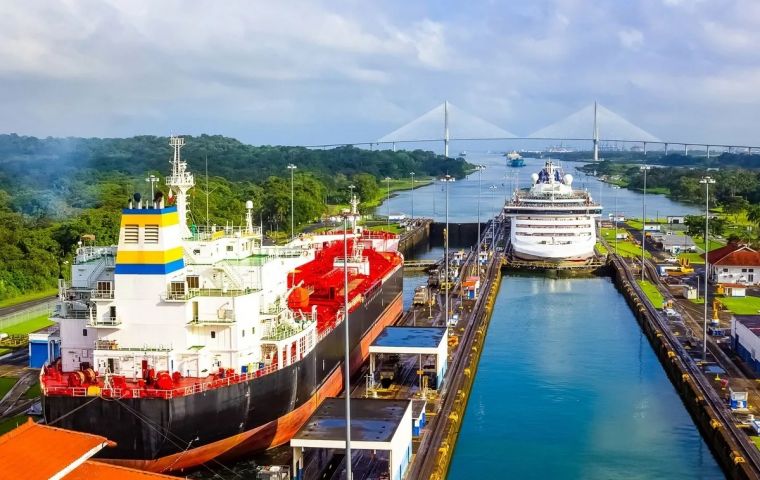MercoPress. South Atlantic News Agency
Panama Canal Authority to explore desalinization plant's potential
 The Panama Canal uses freshwater from two local lakes to fill the locks through which vessels cross from the Atlantic Ocean to the Pacific and vice versa
The Panama Canal uses freshwater from two local lakes to fill the locks through which vessels cross from the Atlantic Ocean to the Pacific and vice versa The Panama Canal Authority (ACP) announced Tuesday that a pilot plan to test the viability of implementing a desalination process was to be carried out in a move to keep the century-old structure fully operational while maintaining the quality of water for human consumption.
The decision was made after an increase in the levels of salt was detected in the Gatun Lake which serves the interoceanic path. Experts claim the abnormality is the result of the drought caused by the El Niño phenomenon, particularly in the Escobal sector, which gets its drinking water from a plant of the state-owned Idaan (Instituto Nacional de Acueductos y Alcantarillados Nacionales).
The canal administration explained that a desalination plant had been installed in Escobal in the northern province of Colon, with a capacity to supply 6,000 people per day. The ACP pointed out that the pilot plan, which is being carried out in coordination with Idaan, will operate for six months and will allow gaining experience in controlled conditions. It also underlined that this project addresses the need to maintain the quality of drinking water for human consumption as a priority while studying longer-term solutions to ensure the quantity and quality of water in the operational-diminished Panama Canal despite recent positive reports.
New water levels will be allowing an increase in the daily number of ships through the man-made interoceanic corridor starting in June, it was announced a fortnight ago after a rainy spell. From May 16 to 31, the total number of neopanamax ships (the larger ones that pass through the expansion inaugurated in 2016) would remain at 7, while panamax ships (those that pass through the century-old smaller locks) would amount to 24. As of June 1, the former category will be increased to 8, while the latter will remain at 24, for a total of 32 vessels. Under optimal conditions, the average number of vessels is between 35 and 36. In 2022, an average of 39 ships per day was welcomed. As of June 15, the maximum draft allowed for ships passing through the new neopanamax locks will be 13.71 meters to ensure “safe navigation,” the ACP added. However, maintenance work from May 7 to 15 will reduce the number of transits through the Panamax locks from 20 to 17 per day.
Since July 2023, daily transits have been limited due to water shortages in the artificial lakes of Gatun and Alhajuela, reaching 22 vessels in November. A further reduction to 18 vessels in February was not necessary. From March 25, a total of 27 vessels have been able to pass daily through the waterway, which serves more than 180 maritime routes connecting 170 countries and reaching some 1,920 ports worldwide. The canal, used mainly by customers from the United States, China, and Japan, has a system of locks to raise and lower ships. For every ship that passes through, 200 million gallons of fresh water are released into the ocean.
Weather conditions worsened by the arrival of the El Niño phenomenon also forced the ACP to reduce the draft (the submerged part of the ship) from a maximum of 50 feet to 44 feet. These restrictions resulted in a significant loss of toll revenue.




Top Comments
Disclaimer & comment rulesCommenting for this story is now closed.
If you have a Facebook account, become a fan and comment on our Facebook Page!